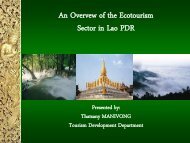GEOLOGY OF THE PENGKALAN HULU-BETONG TRANSECT ...
GEOLOGY OF THE PENGKALAN HULU-BETONG TRANSECT ...
GEOLOGY OF THE PENGKALAN HULU-BETONG TRANSECT ...
You also want an ePaper? Increase the reach of your titles
YUMPU automatically turns print PDFs into web optimized ePapers that Google loves.
68<br />
Ai Yoe Weng mine is located at the Ai Yoe Weng stream, Km 99 on the way from<br />
Yala to Betong (27 km northward of Betong downtown). The bedrock is biotite granite<br />
and covered by phyllitic quartzite in some parts. Generally, cassiterite and scheelite occur<br />
in quartz veins and accumulated in the placers. Three to five tonnes of cassiterite had<br />
been produced monthly by gravel pump mining operation.<br />
vi. Bor Nam Ron-Betong Deposit<br />
This deposit is located at Ban Bor Nam Ron, Betong District, on topographic map<br />
Sheet 5220 IV (Amphoe Betong) at Lat. 5 o 50′ 25″ N – 5 o 54′ 45″ N, Long.<br />
101 o 04′ 00″ E – 101 o 08′ 25″ E. It is within the contact zone of granite and sedimentary<br />
rocks of the Kanchanaburi Formation. Cassiterite normally occurs in quartz veins and<br />
accumulated in the alluvium.<br />
5.2.2 Tungsten<br />
The occurrence of scheelite (calcium tungstate) is widespread in stream sediments (in<br />
trace amount). Wolframite (iron-manganese tungstate) has been recorded on the<br />
Malaysian side at the Temengor area by Jones (1969). On the Thai side, scheelite has also<br />
been found and it was produced as a by product at the Ai Yoe Weng tin mine.<br />
5.2.3 Heavy minerals<br />
On the Malaysian side, Burton (1970) reported that monazite occurred as an accessory<br />
mineral in stream sediments and in some cases it occurs together with considerable<br />
amounts of xenotime. In a fairly large-scale alluvial tin-mining operation, these minerals<br />
could possibly be profitably recovered as by-product.<br />
Thorite and allanite had also been identified. The titanium ore, ilmenite (iron titanate)<br />
is a common accessory mineral in granite and is one of the most abundant mineral found<br />
in the heavy mineral concentrates. Dumps of heavy minerals (amang) discarded during tin<br />
mining operations constitute the main local source of ilmenite.<br />
On the Thai side, heavy minerals such as monazite, xenotime, zircon, rutile, ilmenite<br />
and magnetite occur widespread throughout the area, especially near the granite in the<br />
Transect area.<br />
5.2.4 Gold<br />
On the Malaysian side, Scrivenor (1915) reported that alluvial gold had been mined at<br />
Berusong in the Temengor valley. He believed that the gold probably came from the basic<br />
Pahang Volcanic Series and perhaps from the quartz porphyry in which numerous small<br />
quartz veins were seen. The basic Pahang Volcanic Series rocks are now thought to be<br />
highly altered basic intrusives and the quartz porphyry is now known to be an acid<br />
pyroclastic rock (volcanic rocks of the Gerik formation) rather than an intrusive. The<br />
primary gold mineralization may be of similar mode of occurrence to the tin<br />
mineralization, which is genetically related to the surrounding granite bodies. So far,<br />
there is no record on occurrence of gold on the Thai side.



